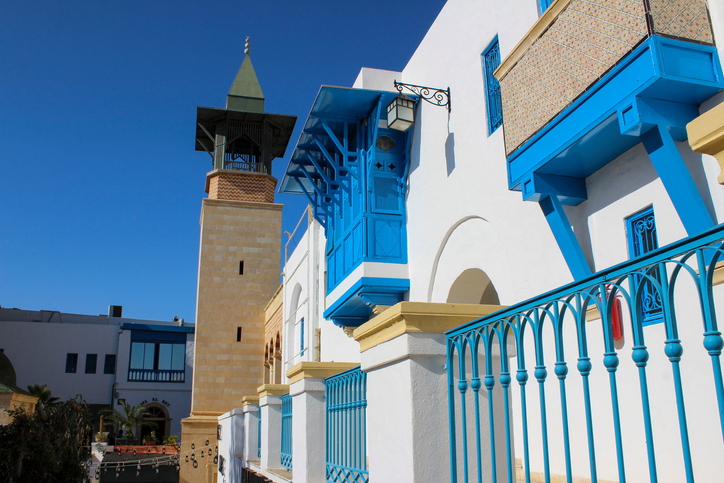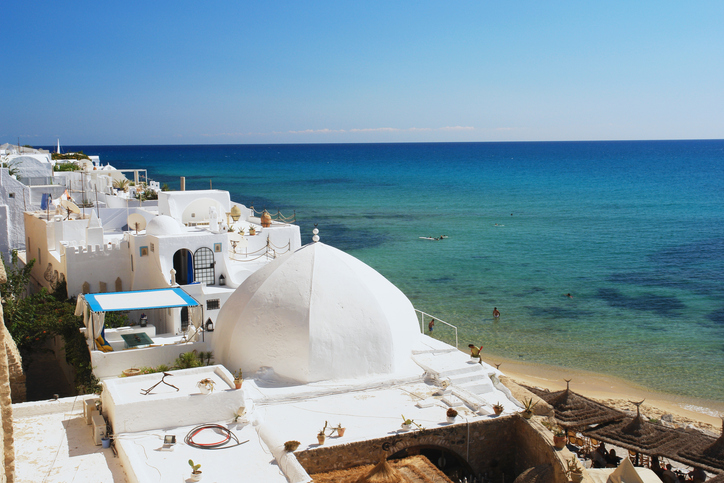Hammamet is one of those cities between the east and west that has become the country’s biggest resort but also managed to retain its spirit and genuine character.
It’s ideally located just 60km south of the city of Tunis and offers a wide range of attractions and possibilities for visitors to enjoy in this city of contrasts. The offer is so complete that it will undoubtedly be the deciding factor in making us choose Hammamet ahead of another destination. You can choose to enjoy the sun and Mediterranean beaches, its ancient history, or simply wander among the many small shops and charming cafés.

More than suggesting some particular monument, we recommend starting with a stroll around to get a feel for the city, wandering through the maze of winding streets and discovering surprising details in the city’s architecture and adobe houses on every corner.
To appreciate the heart of the city, you should also take a stroll down Avenue Habib Bourguiba, where you’ll find the most popular restaurants, shopping centres, galleries and all the main shops.
 Next up, you could visit its prized “old city”, the medina. The best way to enter is through Bab el-Souk, its principal and most monumental entrance. Once inside, you’ll enter the main trading area with an interesting mix of Arab sights, sounds, aromas and flavours, where animals are still the preferred mode of transport. You’ll find scores of colourful stalls displaying local crafts of every description, from rugs to jewellery, teapots and fabrics. This is the best place to buy some souvenirs, but don’t forget to haggle!
Next up, you could visit its prized “old city”, the medina. The best way to enter is through Bab el-Souk, its principal and most monumental entrance. Once inside, you’ll enter the main trading area with an interesting mix of Arab sights, sounds, aromas and flavours, where animals are still the preferred mode of transport. You’ll find scores of colourful stalls displaying local crafts of every description, from rugs to jewellery, teapots and fabrics. This is the best place to buy some souvenirs, but don’t forget to haggle!
Once inside, head into the heart of the medina, and you’ll find the Great Mosque, which was originally the oldest in the city. It was built in the 12th-century, later demolished and rebuilt in 1972.
We also recommend visiting the Kasbah, also known as the Spanish Fort, while you’re still inside the medina. This walled 15th-century building acted as a protective fortress for the city and is located next to the walls of the old city. Make sure to climb up to the top of the ramparts to enjoy the magnificent views of the maze of streets in the medina and the Mediterranean.
 The last spot we’d like to suggest is the Musée dar Hammamet. It has an extensive collection of local art and customs that will help you get a better grasp of the locals’ costumes, tools, ornaments and culture.
The last spot we’d like to suggest is the Musée dar Hammamet. It has an extensive collection of local art and customs that will help you get a better grasp of the locals’ costumes, tools, ornaments and culture.
To finish the day, there’s another special moment to enjoy in Hammamet, sunset. Simple, yet stunning. Find someplace to sit and marvel at the way the sun disappears over the horizon.
After that relaxing break and enjoying the sunset comes the moment when the city streets really come to life. The cafes begin to fill up with locals, and a few hours spent chatting with them is the best way to appreciate the cheerful, easygoing Tunisian character. Most people speak French, and some also speak English so you won’t have too many communication problems.
 But, Hammamet’s true value lies in its beaches. You’ll also find others if you head towards Nabeul and Yasmine, where the most impressive beaches are found about 9km from Hammamet itself.
But, Hammamet’s true value lies in its beaches. You’ll also find others if you head towards Nabeul and Yasmine, where the most impressive beaches are found about 9km from Hammamet itself.
If you still have some free time you could try to visit other towns nearby like Zaghouan or Ain er-Rahma to check out the fantastic Roman ruins at Pheradi Majus, or Bir Bou Regba, where it’s worth taking the time to enjoy the natural beauty of the Faoura River waterfall. Another interesting excursion takes you to the neighbouring town of Pupput (only 6km from Hammamet) where you can discover the remains of another Roman settlement.






